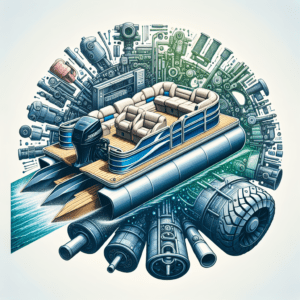Introduction to Pontoon Boat Dynamics
A pontoon boat is a unique watercraft that consists of two or more pontoons, or flotation devices, that are connected by a deck. This type of boat is known for its stability, buoyancy, and smooth ride. The pontoons themselves are a critical component of the boat’s structure, providing the necessary buoyancy and stability to keep the boat afloat. This importance is highlighted by the fact that they are the primary support system for the entire boat, ad with transom they serve as the backbone. The transom in a pontoon boat serves as the connection point between the pontoons and the rest of the boat’s components, including the engine, steering, and other mechanical systems. Understanding the relationship between these two key elements is essential for anyone who owns or operates a pontoon boat.
The Integral Relationship Between Pontoon Logs and the Transom
Pontoon boats are designed with a unique structure that makes them stand out from other watercraft. The pontoon logs or tubes form the primary structure of the boat, providing stability and keeping the vessel afloat. Along with the pontoons, the transom has an interdependent relationship with the entire vessel. To understand how a pontoon boat works, it’s essential to examine the integral relationship between the pontoons and the transom.
Definition and Function of a Transom
The transom is the flat vertical surface at the back of the boat’s hull where the motor is mounted. The function of the transom is to provide stability by keeping the motor at a consistent height and angle of attack. It also supports the weight of the motor and other equipment attached to it.
How Pontoon Logs Support the Transom
The pontoons or tubes are the primary support of the transom, distributing the weight of the motor and other equipment evenly along the length of the vessel. The pontoons’ buoyancy and displacement ability support the weight of the transom and motor, ensuring that the vessel remains balanced and stable, even when running at high speeds.
Impact on Boat Performance and Handling
The relationship between the transom and pontoon logs is critical to the boat’s overall performance and handling. A high-quality pontoon boat with a well-matched transom and pontoons will perform well in all types of water conditions. The correct weight distribution will ensure that the boat handles well in choppy waters and remains stable and comfortable for all onboard.
The Interdependence of Logs and Transom in Weight Distribution
The weight distribution of a pontoon boat depends heavily on the interdependence of the pontoons and transom. An imbalance can cause the boat to list to one side or become unstable in choppy waters. It’s therefore essential to ensure that the transom and pontoons are well-matched and that the correct weight distribution is maintained.
Types of Pontoon Logs and Transom Configurations
Pontoon boats are flexible watercraft that can be used for a variety of boating activities, including fishing, swimming, and cruising. Since pontoon boats rely heavily on its logs and transom for stability and buoyancy, it’s essential to choose the best type of logs and transom that match your boating needs for safe and enjoyable experiences.
A. Different Types of Pontoon Logs
| Log Material | Pros | Cons |
|---|---|---|
| Aluminum | Durable, Lightweight, Corrosion-resistant | Expensive, May Bend in Rough Waters |
| Steel | Rust-resistant, Sturdy | Heavy, Prone to Rust |
| Foam-filled | Provides Buoyancy, Resistant to Leaks | Less Durable, Less Stable |
Aluminum and steel logs are suitable for large pontoons, while foam-filled logs are perfect for smaller, lightweight boats. You need to consider your pontoon’s size, weight capacity, and usage to determine which type of logs will work best for you.
B. Transom Variations and Designs
The transom provides support to the motor, making it one of the essential parts of a pontoon boat. Here are some of the different transom designs and configurations available:
- Standard transom – Most common type
- Extended transom – Provides additional space for storage or swimming
- Tilt and trim transom – Allows you to adjust the motor height as water conditions change
- Ski tow transom – Specially designed for water sports enthusiasts
You need to keep in mind the horsepower of your motor and your boating activities when choosing a transom. If you plan to do water sports, go for a ski tow transom, for example.
C. Matching Logs and Transom to Your Boating Needs
Matching the logs and transom to your boating needs is crucial in ensuring your pontoon’s functionality and performance. Consider these factors when making a decision:
- Your boating activities and anticipated usage
- The size of your pontoon boat
- The weight capacity of the craft
- Motor size and horsepower
- Budget and preference for materials
Take the time to research and understand different log and transom designs and configurations to make sure you choose the right one that matches your needs and preferences.
D. Pros and Cons of Popular Configurations
Here are the pros and cons of some popular pontoon log and transom configurations:
| Pontoon Log and Transom Configuration | Pros | Cons |
|---|---|---|
| Two-Log, Standard Transom | Excellent stability, Efficient Performance | May Struggle in Rough Waters, Limited Storage Space |
| Three-Log, Standard Transom | Smoother Ride, Increased Capacity | Expensive, Fuel Consumption Increases |
| Two-Log, Tilt and Trim Transom | Increased Control, Appropriate for Changing Water Conditions | Expensive, Maintenance Issues |
Understanding the pros and cons of popular configurations will help you make an informed decision that will have long-lasting benefits for your boating experience.
Maintenance, Repairs, and Upgrades for Pontoon Logs with Transom
A. Routine Maintenance for Longevity and Safety
Regular maintenance is key to keeping your pontoon boat safe and in good condition. Here are some routine maintenance tasks to consider:
- Inspect the logs and transom regularly for any signs of damage or wear.
- Clean the logs and transom regularly to avoid buildup of debris and dirt.
- Grease the fittings of the transom assembly to prevent rust and corrosion.
- Check and replace any damaged straps and ropes used to secure the logs and transom.
B. Identifying Signs of Wear and Damage
Identifying signs of wear and damage early can help prevent further damage and costly repairs. Here are some common signs to look for:
- Cracks or holes in the logs or transom.
- Loose or damaged fittings.
- Corrosion or rust on metal fittings or parts.
- Excessive vibration or unusual noise when operating the boat.
C. Steps for Repairing Damaged Pontoon Logs and Transom
If damage is detected, it’s essential to address it promptly to avoid further damage or safety hazards. Here are some steps for repairing damaged logs and transom:
- Assess the extent of the damage and determine if it can be repaired or if replacement is necessary.
- Remove any damaged parts and clean the area thoroughly.
- Repair or replace any fittings or hardware if necessary.
- Fill in any cracks or holes with marine filler and allow it to dry completely before sanding and painting or sealing.
D. Upgrading Your Pontoon Logs and Transom
Upgrading the logs and transom of your pontoon boat can improve its performance and longevity. Here are some upgrades to consider:
| Upgrade | Benefits |
|---|---|
| New, larger diameter logs | Improved stability and buoyancy |
| Stainless steel fittings and hardware | Increased durability and resistance to corrosion |
| Foam-filled logs | Increased buoyancy and reduced noise and vibration |
Remember that upgrading your logs and transom must be done correctly to avoid causing damage or compromising the boat’s integrity. It’s always best to work with a professional or experienced boater to ensure the job is done correctly, and safety is not compromised.
| Key Points | Description |
|---|---|
| Routine Maintenance | Inspect logs and transom, clean regularly, grease fittings, check and replace straps/ropes |
| Identifying Signs of Wear and Damage | Cracks or holes in logs or transom, Loose or damaged fittings, Corrosion or rust, Excessive vibration or unusual noise |
| Repairing Damaged Pontoon Logs and Transom | Assess, Remove damaged parts, Repair/replace fittings or hardware, Fill in cracks or holes with marine filler and wait for it to dry, Sand and paint or seal |
| Upgrading Your Pontoon Logs and Transom | New, larger diameter logs for improved stability and buoyancy, Stainless steel fittings and hardware for increased durability and resistance to corrosion, Foam-filled logs for increased buoyancy and reduced noise and vibration |
Making an Informed Purchase: Selecting the Right Pontoon Logs with Transom for Your Boat
Investing in a pontoon boat is a significant decision, and selecting the right pontoon logs with transom for your boat is equally crucial. You need to consider various factors to ensure that you make an informed purchase that aligns with your needs. Below are some essential tips to guide you in purchasing the best pontoon logs with transom for your boat.
A. Considerations Before Purchasing a Pontoon Boat
Before you start looking at pontoon logs and transom options, it is essential to consider your boating needs. Determine the primary use of your pontoon boat, whether it is for fishing, cruising, or water sports. Also, consider the number of people who will be on board, your budget, the size of the water body you will be using, and how often you plan to use the boat.
B. The Importance of Quality and Compatibility in Logs and Transom
When purchasing pontoon logs with transom, the quality of the materials used is crucial. High-quality logs and transom ensure your boat’s durability, stability, and safety. You also need to ensure that the logs and transom are compatible with each other, ensuring proper weight distribution, performance, and handling of your pontoon boat.
C. Reviews and Recommendations from Experienced Boaters
Reviews and recommendations from experienced boaters can help you make an informed decision before purchasing pontoon logs with transom. Consider checking online reviews and forums, talking to friends and colleagues who own pontoon boats, or seeking professional advice from a reputable dealer. These insights can help you identify the best pontoon logs and transom options for your boat.
D. Final Thoughts on Investing in the Best Pontoon Logs with Transom
Purchasing the best pontoon logs with transom can be challenging, but it’s a crucial step towards owning a stable, durable, and safe pontoon boat. Ensure you consider your boating needs, choose high-quality, compatible materials, and seek recommendations from experienced boaters before making a purchase. With these tips, you’ll be able to invest in the best pontoon logs with transom for your boat, ensuring an enjoyable and safe boating experience for years to come.
Frequently Asked Questions
- What are pontoon logs?
- What is a transom on a pontoon boat?
- What are the different types of pontoon logs and transom configurations?
- How do I perform routine maintenance on my pontoon logs and transom?
Pontoon logs are the long, cylindrical containers attached to a pontoon boat’s bottom that provide buoyancy, stability, and support for the deck. They are typically made of aluminum and provide a pontoon boat with the ability to float and maneuver in shallow waters.
The transom is the flat surface at the back of the pontoon boat that provides support for the engine and helps with steering. It connects the two pontoons to provide stability to the boat.
There are three major types of pontoon logs: round, U-shaped, and elliptical logs. Transom configurations vary in design, including single or dual motor setups, swim platform options, and seating configurations.
Routine maintenance includes cleaning the logs and transom with soap and water, checking for any damages or signs of wear, and ensuring that the logs and transom are secure and correctly aligned. It’s also essential to use protective coatings such as anti-corrosion sprays to prolong the life of the logs and transom.







